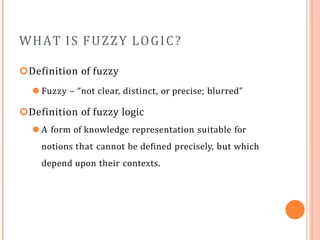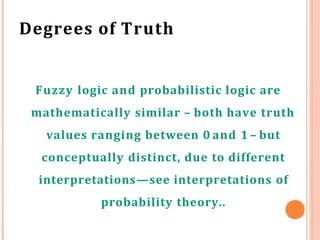fuzzylogic-120105083314-phpapp01.pptx
- 1. FUZZY LO G I C Babu Appat
- 2. OVERVIEW What is Fuzzy Logic? Where did it begin? Fuzzy Logic vs. Neural Networks Fuzzy Logic in Control Systems Fuzzy Logic in Other Fields Future
- 3. WHAT IS FUZZY LOGIC? Definition of fuzzy ⚫ Fuzzy – “not clear, distinct, or precise; blurred” Definition of fuzzy logic ⚫ A form of knowledge representation suitable for notions that cannot be defined precisely, but which depend upon their contexts.
- 4. What is Fuzzy Logic? Fuzzy logic is a form of many-valued logic; it deals with reasoning that is approximate rather than fixed and exact. In contrast with traditional logic theory, where binary sets have two-valued logic: true or false, fuzzy logic variables may have a truth value that ranges in degree
- 5. What is Fuzzy Logic? Fuzzy logic has been extended to handle the concept of partial truth, where the truth value may range between completely true and completely false. Furthermore, when linguistic variables are used, these degrees may be managed by specific functions
- 6. Fuzzy Logic began Fuzzy logic began with the 1965 proposal of fuzzy set theory by Lotfi Zadeh Fuzzy logic has been applied to many fields, from control theory to artificial intelligence
- 7. Fuzzy Data- Crisp Data • he reasoning in fuzzy logic is similar to human reasoning • It allows for approximate values and inferences as well as incomplete or ambiguous data
- 8. Fuzzy Data- Crisp Data • Fuzzy logic is able to process incomplete data and provide approximate solutions to problems other methods find difficult to solve.
- 9. Fuzzy Data- Crisp Data • Terminology used in fuzzy logic not used in other methods are: very high, increasing, somewhat decreased, reasonable and very low.
- 10. Degrees of Truth Fuzzy logic and probabilistic logic are mathematically similar – both have truth values ranging between 0 and 1 – but conceptually distinct, due to different interpretations—see interpretations of probability theory..
- 11. Degrees of Truth Fuzzy logic corresponds to "degrees of truth", while probabilistic logic corresponds to "probability, likelihood"; as these differ, fuzzy logic and probabilistic logic yield different models of the same real-world situations.
- 12. Degrees of Truth Both degrees of truth and probabilities range between 0 and 1 and hence may seem similar at first. For example, let a 100 ml glass contain 30 ml of water. Then we may consider two concepts: Empty and Full. The meaning of each of them can be represented by a certain fuzzy set.
- 13. Degrees of Truth Then one might define the glass as being 0.7 empty and 0.3 full. Note that the concept of emptiness would be subjective and thus would depend on the observer or designer.
- 14. Degrees of Truth Another designer might equally well design a set membership function where the glass would be considered full for all values down to 50 ml. It is essential to realize that fuzzy logic uses truth degrees as a mathematical model of the vagueness phenomenon while probability is a mathematical model of ignorance.
- 15. Applying the Values A basic application might characterize subranges of a continuous variable. For instance, a temperature measurement for anti-lock brakes might have several separate membership functions defining particular temperature ranges needed to control the brakes properly.
- 16. Applying the Values Each function maps the same temperature value to a truth value in the 0 to 1 range. These truth values can then be used to determine how the brakes should be controlled
- 18. Applying the Values In this image, the meaning of the expressions cold, warm, and hot is represented by functions mapping a temperature scale. A point on that scale has three "truth values"—one for each of the three functions.
- 19. Applying the Values The vertical line in the image represents a particular temperature that the three arrows (truth values) gauge. Since the red arrow points to zero, this temperature may be interpreted as "not hot". The orange arrow (pointing at 0.2) may describe it as "slightly warm" and the blue arrow (pointing at 0.8) "fairly cold"
- 20. TRADITIONAL REPRESENTATION OF LOGIC Slow Speed = 0 bool speed; get the speed if ( speed == 0) { Fast Speed = 1 // speed is slow } else { // speed is fast }
- 21. FUZZY LOGIC REPRESENTATION For every problem must represent in terms of fuzzy sets. What are fuzzy sets? Slowest [ 0.0 – 0.25 ] Fastest [ 0.75 – 1.00 ] Slow [ 0.25 – 0.50 ] Fast [ 0.50 – 0.75 ]
- 22. FUZZY LOGIC REPRESENTATION CONT. Slowest Fastest if ((speed >= 0.0)&&(speed < 0.25)) { // speed is slowest } else if ((speed >= 0.25)&&(speed < 0.5)) { // speed is slow } else if ((speed >= 0.5)&&(speed < 0.75)) { // speed is fast } else // speed >= 0.75 && speed < 1.0 { // speed is fastest } Slow float speed; get the speed Fast
- 23. Linguistic Variables While variables in mathematics usually take numerical values, in fuzzy logic applications, the non-numeric linguistic variables are often used to facilitate the expression of rules and facts
- 24. Linguistic Variables A linguistic variable such as age may have a value such as young or its antonym old. However, the great utility of linguistic variables is that they can be modified via linguistic hedges applied to primary terms. The linguistic hedges can be associated with certain functions
- 25. Examples Fuzzy set theory defines fuzzy operators on fuzzy sets. The problem in applying this is that the appropriate fuzzy operator may not be known. For this reason, fuzzy logic usually uses IF-THEN rules, or constructs that are equivalent, such as fuzzy associative matrices Rules are usually expressed in the form: IF variable IS property THEN action
- 26. that uses a fan might look like this: IF temperature IS very cold THEN stop fan IF temperature IS cold THEN turn down fan IF temperature IS normal THEN maintain level IF temperature IS hot THEN speed up fan There is no "ELSE" – all of the rules are evaluated, because the temperature might be "cold" and
- 27. ORIGINS OF FUZZY LOGIC Traces back to Ancient Greece Lotfi Asker Zadeh ( 1965 ) ⚫ First to publish ideas of fuzzy logic. Professor Toshire Terano ( 1972 ) ⚫ Organized the world's first working group on fuzzy systems. F.L. Smidth & Co. ( 1980 ) ⚫ First to market fuzzy expert systems.
- 28. FUZZY LOGIC VS. NEURAL NETWORKS How does a Neural Network work? Both model the human brain. ⚫ Fuzzy Logic ⚫ Neural Networks Both used to create behavioral systems.
- 29. FUZZY LOGIC IN CONTROL SYSTEMS Fuzzy Logic provides a more efficient and resourceful way to solve Control Systems. Some Examples ⚫ Temperature Controller ⚫ Anti – Lock Break System ( ABS )
- 30. TEMPERATURE CONTROLLER The problem ⚫ Change the speed of a heater fan, based off the room temperature and humidity. A temperature control system has four settings ⚫ Cold, Cool, Warm, and Hot Humidity can be defined by: ⚫ Low, Medium, and High Using this we can define the fuzzy set.
- 31. BENEFITS OF USING FUZZY LOGIC
- 32. ANTI LOCK BREAK SYSTEM ( ABS ) Nonlinear and dynamic in nature Inputs for Intel Fuzzy ABS are derived from ⚫ Brake ⚫ 4 WD ⚫ Feedback ⚫ Wheel speed ⚫ Ignition Outputs ⚫ Pulsewidth ⚫ Error lamp
- 33. FUZZY LOGIC IN OTHER FIELDS Business Hybrid Modelling Expert Systems
- 34. CONCLUSION Fuzzy logic provides an alternative way to represent linguistic and subjective attributes of the real world in computing. It is able to be applied to control systems and other applications in order to improve the efficiency and simplicity of the design process.




















![FUZZY LOGIC REPRESENTATION
For every problem
must represent in
terms of fuzzy sets.
What are fuzzy
sets?
Slowest
[ 0.0 – 0.25 ]
Fastest
[ 0.75 – 1.00 ]
Slow
[ 0.25 – 0.50 ]
Fast
[ 0.50 – 0.75 ]](https://image.slidesharecdn.com/fuzzylogic-120105083314-phpapp01-230501222955-0c7d5fdb/85/fuzzylogic-120105083314-phpapp01-pptx-21-320.jpg)














